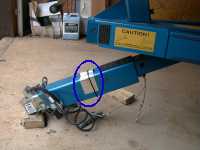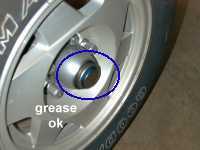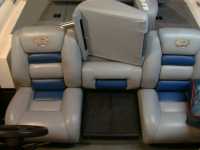
Rip's Tips - Settling In  |
Other tip pages: general comments | rigging | settling in | fixing stuff | gadgets | discussion
| This particular tip page series highlights little stuff I learned about my '99 TR21 the first month or so out on the water... |

above - strapped down cap above - plastic cap over hole and brake cap stored, Wesbar 5-plug above - brake release cap removed, ready to store above - make your own wire-plug adapter |
Tip: Retractable Tongue, Brake Lockout - I
really like the convenient retractable tongue
on the MFI tandem axel trailer. It lets me get
around my Triton in the garage.
Help!!! Any ideas about how to attach a bow-eye safety chain to the MFI trailer? My '99 does not have one to back up the winch strap. Notice I have a plastic tie on the brake lock-out cap/dial. This little metal dial on the UFP brake actuator kept getting loose and coming off. Mike Witt's service tech, Mike VanNatta, recommended this temporary solution. If you have a similar situation or learned a better quality solution, please email me.
Update... UFP makes a plastic cap for actuators without the metal brake release dial. Simply use the plastic cap for everyday use and store the metal release dial safely in the glovebox for when the dealer or you might be moving trailer with wires not connected. That new wire plug connector (five) on my disc-braked tandem axle trailer is not like my old plug (four). The extra wire hooks up to the vehicle backup light to activate the brake release solenoid on the trailer. I couldn't find a similar plug to wire my other truck at local auto parts or trailer supply stores. I wanted to give local marine dealers some business, so I contacted Wesbar for the part numbers to place an order. On the vehicle side (female), mine's a Wesbar "5-flat trunk connector" part #7273. On the trailer side (male), mine's a Wesbar "5-flat trailer connector - wishbone" part #7283. (Thanks to Mike Walter, sales manager at Wesbar, for this info). Link to Wesbar on link list page. It seems to be designed so it can connect to most other four connector plugs but the extra connector left open needs a feed from a back-up light circuit. You can patch-rig it to use a friend's tow vehicle. If you or your friend have a round 7-prong plug on the truck for trailer light connections, you can order a Wesbar #7257 round-7 to 5-flat prong adapter for about $24 or custom-make one like I did before the adapter was available (see picture). |

above - hub has adequate grease above - hub needs a little grease |
Tip: Bearing Grease Level - I read in the
Trailer Buddy bearing manual about how to
tell when these new style "blue cylinder"
Stainless Steel Wheel Bearing Protectors
need grease. The blue Auto Check cylinder
should be out just a bit beyond the rim of the
Trailer Buddy bearing cap for normal grease
levels.
When the blue cylinder retracts back even with the rim of the Trailer Buddy bearing cap, it needs a little more grease. To get to the grease fitting, "carefully" pry the little chrome cap off the end of the blue cylinder. The flat cap is snapped in with small tabs all around its edge. It's metal, but the cylinder is plastic. One of mine was already chipped when I looked at it the first time. Read and follow instructions in the bearing manual. There's also info about replacement wheel bearing seals and stuff that you'll need some day many years from now. Don't lose it.
Update - Observe your protectors, don't overfill but maintain grease at recommended levels. Grease leaking around a stainless protector cap should be inspected by your dealer for possible replacement. |

above - middle seat removed to reveal step |
Tip: Removable Seats - Did your dealer or a
friend show you that the center seat on the
dual consoles comes off to reveal a
convenient step to the back deck?
You don't have to tear up that upholstery going to the back.
Update - A couple Triton owners advised BFHP readers that the convenient removable nature of these seats can also be inconvenient if they accidently come loose at the wrong time, like on the lake or roadways. They're held secure by a metal pin and velcro strip on the TR21. So far, mine are tight. If any of you would like to share ideas about making them more secure, please email me. |
Return to Rip's Tips main page.
Also consider exploring BBC Home Page for Bryan Bass Club information and links to other bass fishing/boating sites.
Ray's Triton Page | Buying Adventure | Area Dealers | Rip's Triton Tips | Other Links | BBC | Ripstips Home
For corrections on this page series, please contact Ray Rippstein at r-rippstein@tamu.edu
Thanks for visiting.
This intro page last updated July 3, 2006